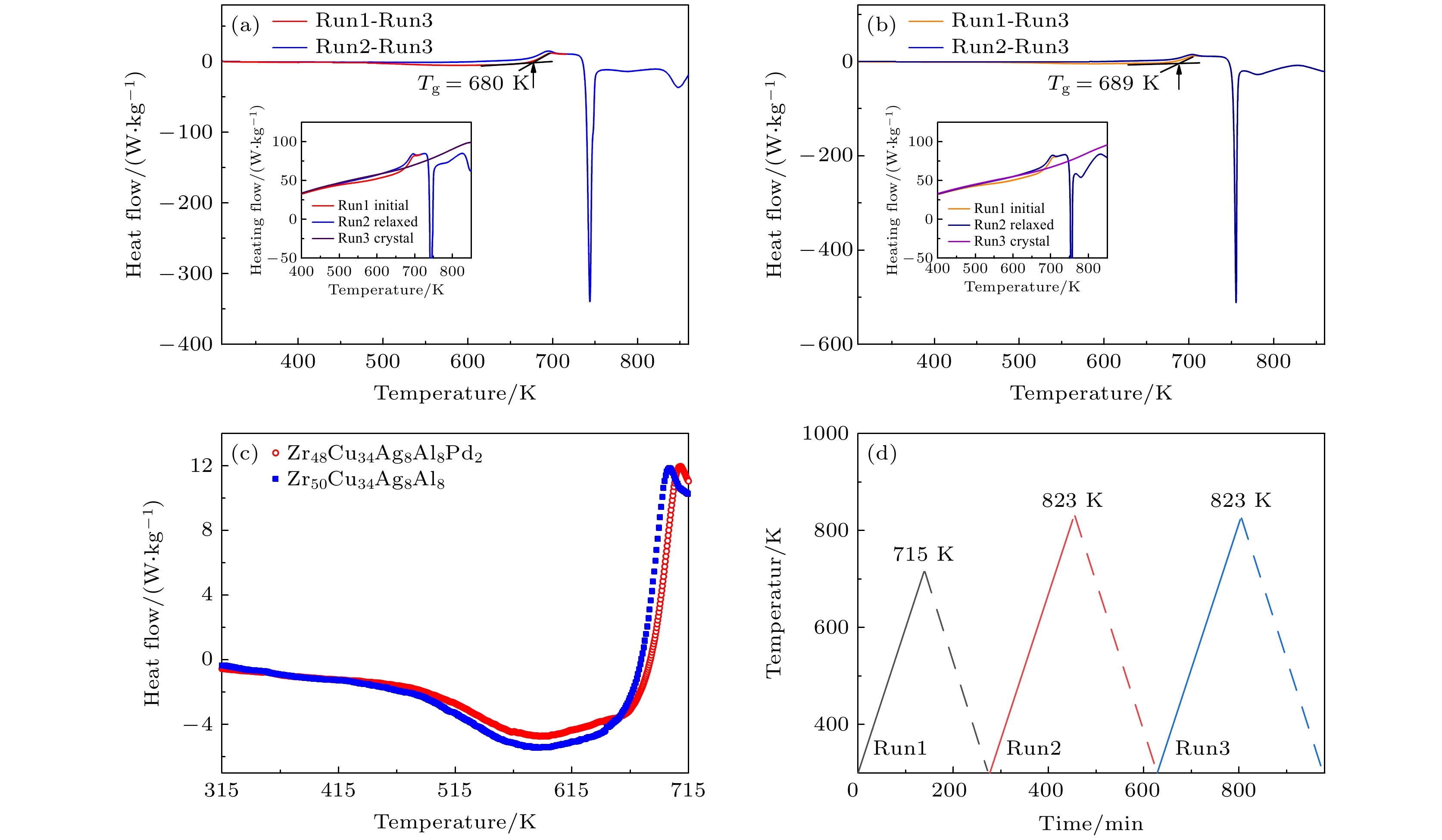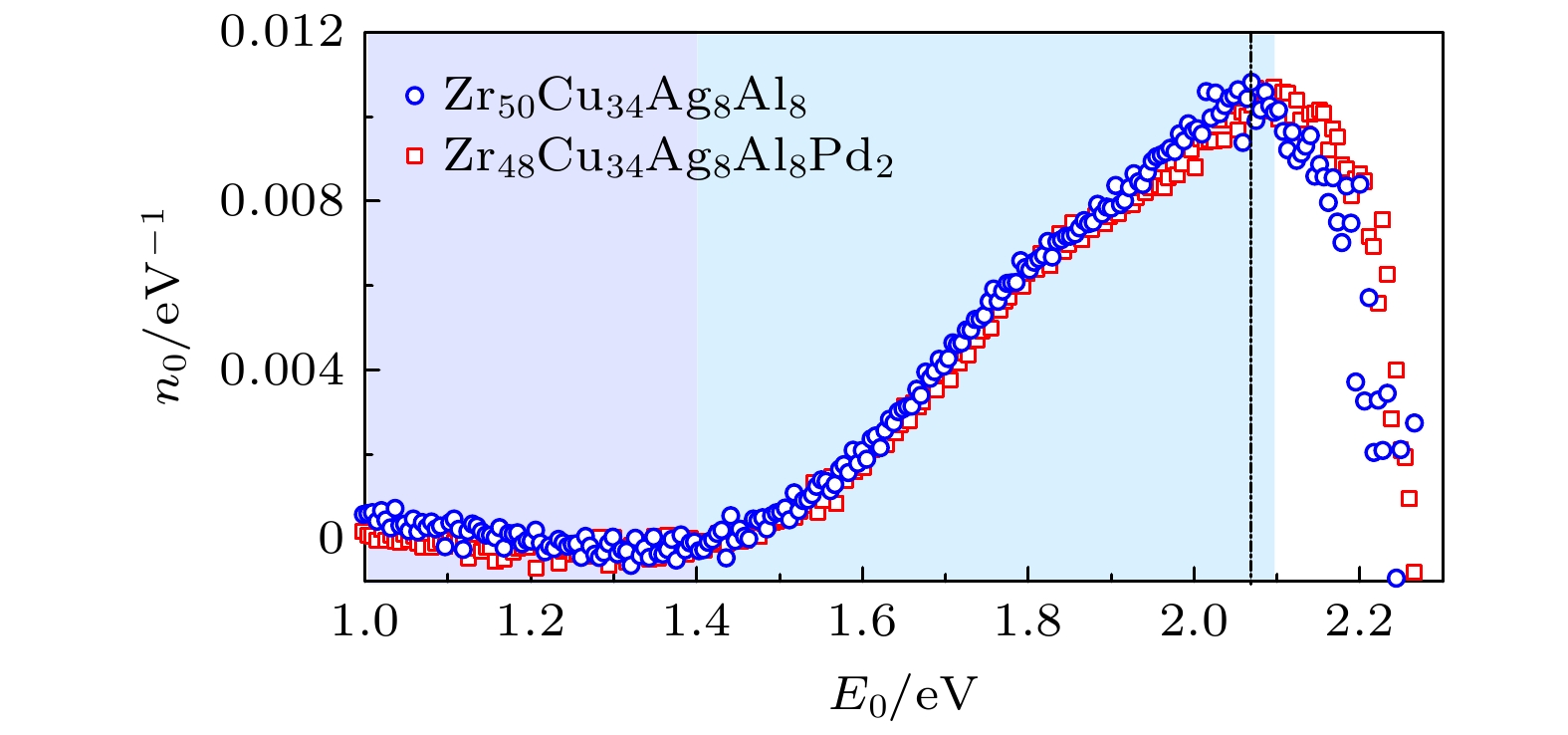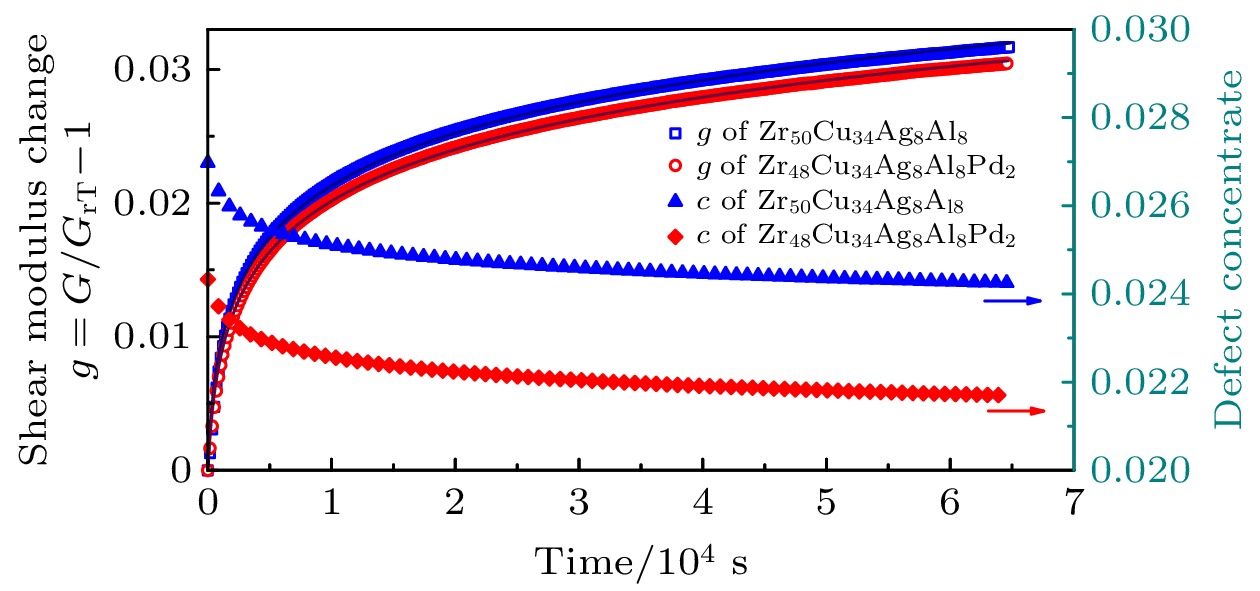-
非晶合金具有独特物理和力学性能, 如何建立非晶合金微观结构非均匀性与物理/力学性能之间的关联是非晶固体的重要研究课题之一. 微合金化是调控非晶合金微观结构有效手段之一. 本研究以玻璃形成能力优异的Zr50–xCu34Ag8Al8Pdx (x = 0, 2)非晶合金为模型合金, 借助差示扫描量热仪和电磁声转换设备, 研究非晶合金铸态、弛豫态和结晶态热流和剪切模量随温度的演化规律, 以及物理时效(低于玻璃转变温度)过程剪切模量的变化随时间演化规律. 基于自间隙原子理论, 利用热流曲线表征非晶合金在相同热历史剪切模量热效应. 通过分析铸态和弛豫态自间隙缺陷浓度和激活能谱, 发现结构弛豫导致自间隙缺陷浓度减小, 诱导剪切模量随温度演化偏离软化过程, 并伴随体系放热. 与此同时, 研究发现添加微量Pd元素可抑制模型合金体系原子迁移, 增加特征弛豫时间. 本研究从非晶合金模量热效应角度进一步理解非晶合金微观结构非均匀性.Amorphous alloys exhibit unique physical and mechanical properties, which are closely connected with their microstructural heterogeneity. The correlation between structural heterogeneity and mechanical properties is one of the important issues of amorphous alloys. Micro-alloying is an effective way to tune the mechanical and physical properties of amorphous alloys. In the present study, Zr50–xCu34Ag8Al8Pdx (x = 0 and 2) amorphous alloys with ability to form excellent glass are chosen as model alloys. The evolutions of heat flow and shear modulus in different states (as-cast, relaxed and crystalline) with temperature of Zr50–xCu34Ag8Al8Pdx (x = 0 and 2) glass system are studied by differential scanning calorimetry (DSC) and electromagnetic-acoustic transformation (EMAT) technique, respectively. The experiment demonstrates that a decrease of the shear modulus is accompanied by the endothermic heat flow and vice versa. The correlation between the heat flow and shear modulus is investigated according to the interstitialcy theory. The calculations of the interstitialcy defect concentration and activation energy spectra suggest that the microstructure remains stable at relatively low temperatures. When temperature increases, the interstitialcy defect structure is activated. Compared with that in the as-cast state, the interstitialcy defect concentration in the relaxed state is reduced by structural relaxation, indicating that temperature-dependent shear modulus softening is inhibited. At temperatures above glass transition temperature, a rapid growth of interstitialcy defect concentration results in the accelerated shear softening, which is accompanied by significant endothermic heat flow. It is noted that the minor addition of palladium reduces the interstitialcy defect concentration in the Zr50–xCu34Ag8Al8Pdx (x = 0 and 2) metallic glass systems. It is suggested that the introduction of Pd reduces the atomic mobility and increases the characteristic relaxation time. In parallel, the change of shear modulus as a function of the aging time (below the glass transition temperature) is studied by using EMAT equipment. The results indicate that the interstitialcy defect concentration decreases in the physical aging process, which is accompanied by an increase of shear modulus. The interstitialcy defect concentration and shear modulus change towards the quasi-equilibrium state with aging time increasing. A reduction of the interstitialcy defect concentration leads to a decrease of the shear modulus change upon microalloying by Pd into Zr50–x Cu34Ag8Al8Pdx (x = 0 and 2) metallic glass system.
[1] Qiao J C, Wang Q, Crespo D, Yang Y, Pelletier J M 2017 Chin. Phys. B 26 016402
 Google Scholar
Google Scholar
[2] Debenedetti P G, Stillinger F H 2001 Nature 410 259
 Google Scholar
Google Scholar
[3] Torquato S 2000 Nature 405 521
 Google Scholar
Google Scholar
[4] 王军强, 欧阳酥 2017 物理学报 66 176102
 Google Scholar
Google Scholar
Wang J Q, Ouyang S 2017 Acta Phys. Sin. 66 176102
 Google Scholar
Google Scholar
[5] Qiao J C, Wang Q, Pelletier J M, Kato H, Casalini R, Crespo D, Pineda E, Yao Y, Yang Y 2019 Prog. Mater Sci. 104 250
 Google Scholar
Google Scholar
[6] Wang W H 2012 Prog. Mater Sci. 57 487
 Google Scholar
Google Scholar
[7] 王峥, 汪卫华 2017 物理学报 66 176103
 Google Scholar
Google Scholar
Wang Z, Wang W H 2017 Acta Phys. Sin. 66 176103
 Google Scholar
Google Scholar
[8] Perez J 1988 Polymer 29 483
 Google Scholar
Google Scholar
[9] Perez J 1990 Solid State Ion. 39 69
 Google Scholar
Google Scholar
[10] Spaepen F 1977 Acta Metall. 25 407
[11] Dyre, J C 2008 Rev. Mod. Phys. 78 953
[12] Makarov A S, Khonik V A, Mitrofanov Y P, Granato A V, Joncich D M, Khonik S V 2013 Appl. Phys. Lett. 102 091908
 Google Scholar
Google Scholar
[13] Chen H S 1980 Rep. Prog. Phys. 43 353
 Google Scholar
Google Scholar
[14] Kobelev N P, Khonik V A 2015 J. Non-Cryst. Solids 427 184
 Google Scholar
Google Scholar
[15] Khonik V A 2015 Metals 5 504
 Google Scholar
Google Scholar
[16] Demetriou M D, Harmon J S, Tao M, Duan G, Samwer K, Johnson W L 2006 Phys. Rev. Lett. 97 065502
 Google Scholar
Google Scholar
[17] Granato A V 1992 Phys. Rev. Lett. 68 974
 Google Scholar
Google Scholar
[18] Granato A V 2014 Eur. Phys. J. B 87 18
 Google Scholar
Google Scholar
[19] Khonik V A 2017 Chin. Phys. B 26 016401
 Google Scholar
Google Scholar
[20] Makarov A S, Mitrofanov Y P, Afonin G V, Kobelev N P, Khonik V A 2019 Scripta Mater. 168 10
 Google Scholar
Google Scholar
[21] Hao Q, Qiao J C, Goncharova E V, Afonin G V, Liu M N, Cheng Y T, Khonik V A 2020 Chin. Phys. B 29 86402
 Google Scholar
Google Scholar
[22] Duan Y J, Qiao J C, Crespo D, Goncharova E V, Makarov A S, Afonin G V, Khonik V A 2020 J. Alloys Compd. 830 154564
 Google Scholar
Google Scholar
[23] Jiang Q K, Wang X D, Nie X P, Zhang G Q, Ma H, Fecht H J, Bednarcik J, Franz H, Liu Y G, Cao Q P, Jiang J Z 2008 Acta Mater. 56 1785
 Google Scholar
Google Scholar
[24] Afonin G V, Mitrofanov Y P, Makarov A S, Kobelev N P, Wang W H, Khonik V A 2016 Acta Mater. 115 204
 Google Scholar
Google Scholar
[25] 张浪渟, Khonik V A, 乔吉超 2020 力学学报 52 1709
 Google Scholar
Google Scholar
Zhang L T, Khonik V A, Qiao J C 2020 Chin. J Theor. Appl. Mech. 52 1709
 Google Scholar
Google Scholar
[26] Cheng Y T, Hao Q, Qiao J C, Crespo D, Pineda E, Pelletier J M 2021 J. Non-Cryst. Solids 553 120496
 Google Scholar
Google Scholar
[27] Vasilev A N, Gaidukov Y P 1983 Uspekhi Fizicheskikh Nauk 141 431
 Google Scholar
Google Scholar
[28] Zhang W, Zhang Q, Inoue A 2008 Adv. Eng. Mater. 10 1034
 Google Scholar
Google Scholar
[29] Makarov S, Mitrofanov Y P, Afonin G V, Kobelev N P, Khonik V A 2017 Intermetallics 87 1
 Google Scholar
Google Scholar
[30] Tao K, Qiao J C, He Q F, Song K K, Yang Y 2021 Int. J. Mech. Sci. 201 106469
 Google Scholar
Google Scholar
[31] Khonik S V, Granato A V, Joncich D M, Pompe A, Khonik V A 2008 Phys. Rev. Lett. 100 065501
 Google Scholar
Google Scholar
[32] Ma E 2015 Nat. Mater. 14 547
 Google Scholar
Google Scholar
[33] Yu H B, Shen X, Wang Z, Gu L, Wang W H, Bai H Y 2012 Phys. Rev. Lett. 108 015504
 Google Scholar
Google Scholar
[34] Shen J, Huang Y J, Sun J F 2007 J. Mater. Res. 22 3067
 Google Scholar
Google Scholar
[35] Ketov S V, Sun Y H, Nachum S, Lu Z, Checchi A, Beraldin A R, Bai H Y, Wang W H, Louzguine-Luzgin D V, Carpenter M A, Greer A L 2015 Nature 524 200
 Google Scholar
Google Scholar
[36] Park K W, Lee C M, Wakeda M, Shibutani Y, Falk M L, Lee J C 2008 Acta Mater. 56 5440
 Google Scholar
Google Scholar
[37] Tong Y, Iwashita T, Dmowski W, Bei H, Yokoyama Y, Egami T 2015 Acta Mater. 86 240
 Google Scholar
Google Scholar
[38] Lu Z, Jiao W, Wang W H, Bai H Y 2014 Phys. Rev. Lett. 113 045501
 Google Scholar
Google Scholar
[39] Qiao J C, Yao Y, Pelletier J M, Keer L M 2016 Int. J. Plast. 82 62
 Google Scholar
Google Scholar
-
图 1 (a) Zr50Cu34Ag8Al8和(b)Zr48Cu34Ag8Al8Pd2非晶合金DSC曲线. Run1为由室温升温至715 K的过程, Run2为室温升温至823 K的过程, Run3为室温升温至823 K的过程. 升温速率为3 K/min; (c) Zr50–xCu34Ag8Al8Pdx(x = 0, 2)非晶合金铸态DSC曲线; (d)升温过程示意图
Fig. 1. (a) DSC curves of Zr50Cu34Ag8Al8 and (b) Zr48Cu34Ag8Al8Pd2 metallic glasses. Run1, Run2 and Run3 correspond to heating from room temperature up to 715 K, 823 K and 823 K, respectively; (c) DSC curves of Zr50–xCu34Ag8Al8Pdx (x = 0, 2) metallic glasses (as-cast state) on an enlarged scale; (d) schematic diagram of heating process.
图 3 Zr50–xCu34Ag8Al8Pdx (x = 0, 2)非晶合金的(a)铸态和弛豫态自间隙缺陷浓度以及(b)自间隙缺陷浓度随温度的变化率(
${{{\rm{d}}c(T)} / {{\rm{d}}T}}$ )随温度的演化Fig. 3. (a) Evolution of the defect concentration in the as-cast and relaxed samples and (b) the rate of defect concentration change (
${{{\rm{d}}c(T)} / {{\rm{d}}T}}$ ) as a function of temperature for Zr50–xCu34Ag8Al8Pdx (x = 0, 2) metallic glasses. -
[1] Qiao J C, Wang Q, Crespo D, Yang Y, Pelletier J M 2017 Chin. Phys. B 26 016402
 Google Scholar
Google Scholar
[2] Debenedetti P G, Stillinger F H 2001 Nature 410 259
 Google Scholar
Google Scholar
[3] Torquato S 2000 Nature 405 521
 Google Scholar
Google Scholar
[4] 王军强, 欧阳酥 2017 物理学报 66 176102
 Google Scholar
Google Scholar
Wang J Q, Ouyang S 2017 Acta Phys. Sin. 66 176102
 Google Scholar
Google Scholar
[5] Qiao J C, Wang Q, Pelletier J M, Kato H, Casalini R, Crespo D, Pineda E, Yao Y, Yang Y 2019 Prog. Mater Sci. 104 250
 Google Scholar
Google Scholar
[6] Wang W H 2012 Prog. Mater Sci. 57 487
 Google Scholar
Google Scholar
[7] 王峥, 汪卫华 2017 物理学报 66 176103
 Google Scholar
Google Scholar
Wang Z, Wang W H 2017 Acta Phys. Sin. 66 176103
 Google Scholar
Google Scholar
[8] Perez J 1988 Polymer 29 483
 Google Scholar
Google Scholar
[9] Perez J 1990 Solid State Ion. 39 69
 Google Scholar
Google Scholar
[10] Spaepen F 1977 Acta Metall. 25 407
[11] Dyre, J C 2008 Rev. Mod. Phys. 78 953
[12] Makarov A S, Khonik V A, Mitrofanov Y P, Granato A V, Joncich D M, Khonik S V 2013 Appl. Phys. Lett. 102 091908
 Google Scholar
Google Scholar
[13] Chen H S 1980 Rep. Prog. Phys. 43 353
 Google Scholar
Google Scholar
[14] Kobelev N P, Khonik V A 2015 J. Non-Cryst. Solids 427 184
 Google Scholar
Google Scholar
[15] Khonik V A 2015 Metals 5 504
 Google Scholar
Google Scholar
[16] Demetriou M D, Harmon J S, Tao M, Duan G, Samwer K, Johnson W L 2006 Phys. Rev. Lett. 97 065502
 Google Scholar
Google Scholar
[17] Granato A V 1992 Phys. Rev. Lett. 68 974
 Google Scholar
Google Scholar
[18] Granato A V 2014 Eur. Phys. J. B 87 18
 Google Scholar
Google Scholar
[19] Khonik V A 2017 Chin. Phys. B 26 016401
 Google Scholar
Google Scholar
[20] Makarov A S, Mitrofanov Y P, Afonin G V, Kobelev N P, Khonik V A 2019 Scripta Mater. 168 10
 Google Scholar
Google Scholar
[21] Hao Q, Qiao J C, Goncharova E V, Afonin G V, Liu M N, Cheng Y T, Khonik V A 2020 Chin. Phys. B 29 86402
 Google Scholar
Google Scholar
[22] Duan Y J, Qiao J C, Crespo D, Goncharova E V, Makarov A S, Afonin G V, Khonik V A 2020 J. Alloys Compd. 830 154564
 Google Scholar
Google Scholar
[23] Jiang Q K, Wang X D, Nie X P, Zhang G Q, Ma H, Fecht H J, Bednarcik J, Franz H, Liu Y G, Cao Q P, Jiang J Z 2008 Acta Mater. 56 1785
 Google Scholar
Google Scholar
[24] Afonin G V, Mitrofanov Y P, Makarov A S, Kobelev N P, Wang W H, Khonik V A 2016 Acta Mater. 115 204
 Google Scholar
Google Scholar
[25] 张浪渟, Khonik V A, 乔吉超 2020 力学学报 52 1709
 Google Scholar
Google Scholar
Zhang L T, Khonik V A, Qiao J C 2020 Chin. J Theor. Appl. Mech. 52 1709
 Google Scholar
Google Scholar
[26] Cheng Y T, Hao Q, Qiao J C, Crespo D, Pineda E, Pelletier J M 2021 J. Non-Cryst. Solids 553 120496
 Google Scholar
Google Scholar
[27] Vasilev A N, Gaidukov Y P 1983 Uspekhi Fizicheskikh Nauk 141 431
 Google Scholar
Google Scholar
[28] Zhang W, Zhang Q, Inoue A 2008 Adv. Eng. Mater. 10 1034
 Google Scholar
Google Scholar
[29] Makarov S, Mitrofanov Y P, Afonin G V, Kobelev N P, Khonik V A 2017 Intermetallics 87 1
 Google Scholar
Google Scholar
[30] Tao K, Qiao J C, He Q F, Song K K, Yang Y 2021 Int. J. Mech. Sci. 201 106469
 Google Scholar
Google Scholar
[31] Khonik S V, Granato A V, Joncich D M, Pompe A, Khonik V A 2008 Phys. Rev. Lett. 100 065501
 Google Scholar
Google Scholar
[32] Ma E 2015 Nat. Mater. 14 547
 Google Scholar
Google Scholar
[33] Yu H B, Shen X, Wang Z, Gu L, Wang W H, Bai H Y 2012 Phys. Rev. Lett. 108 015504
 Google Scholar
Google Scholar
[34] Shen J, Huang Y J, Sun J F 2007 J. Mater. Res. 22 3067
 Google Scholar
Google Scholar
[35] Ketov S V, Sun Y H, Nachum S, Lu Z, Checchi A, Beraldin A R, Bai H Y, Wang W H, Louzguine-Luzgin D V, Carpenter M A, Greer A L 2015 Nature 524 200
 Google Scholar
Google Scholar
[36] Park K W, Lee C M, Wakeda M, Shibutani Y, Falk M L, Lee J C 2008 Acta Mater. 56 5440
 Google Scholar
Google Scholar
[37] Tong Y, Iwashita T, Dmowski W, Bei H, Yokoyama Y, Egami T 2015 Acta Mater. 86 240
 Google Scholar
Google Scholar
[38] Lu Z, Jiao W, Wang W H, Bai H Y 2014 Phys. Rev. Lett. 113 045501
 Google Scholar
Google Scholar
[39] Qiao J C, Yao Y, Pelletier J M, Keer L M 2016 Int. J. Plast. 82 62
 Google Scholar
Google Scholar
计量
- 文章访问数: 8221
- PDF下载量: 84
- 被引次数: 0














 下载:
下载:








